Robots in Spine Surgery and Interview with Dr Kornelis Poelstra
Global Spine Focus
AOSpine Past Fellows are gathering at Global Spine Congress 2017
AOSpine Member Representative – Presentation of shortlisted applicants
AOSpine Members-only sessions at the Global Spine Congress
AOSpine Europe and Middle East

AOSpine Knowledge
Forums – A pioneering concept generating knowledge for the future
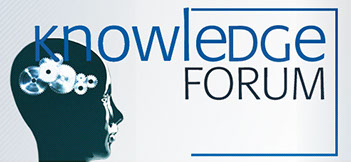
AOSpine Knowledge Forums (KF) have been singled out as having had the "biggest impact in the AO in the last decade", for being responsible for AOSpine's unique academic status among the spine societies, and for being the most visionary initiative from long-time AO contributor professor Luiz Vialle. The KFs already secured their place in history by becoming a premier knowledge creator in the field of spine surgery.(*) But Vialle didn't stop here: to complete the research cycle, the results need to be translated into education; to have a benefit for the patients, the outcomes must be transferred into clinical practice.
AOSpine International Board chairperson Dan Riew agrees: "We have the resources and the vision. Today, we are the largest and best funded collaborative research organization in the spine world. With that leadership, we have a responsibility to use our resources wisely and effectively." AOSpine is constantly on the lookout for tangible outcomes from its studies to fulfill this task. But to get to this point, you had to first dream big and then work hard; start with fundamentals, go as far as put in place a new administrative structure, something Vialle is proud to say, is now modeled by all AO clinical divisions.
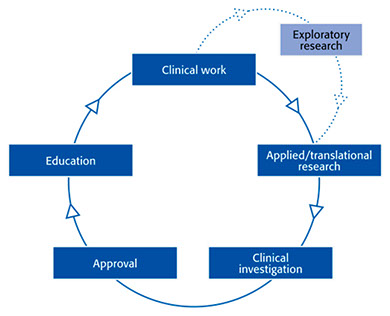
AOSpine Knowledge Forums are international working groups in five pathologies: tumor, deformity, spinal cord injury, trauma, and degenerative disease. Each is composed of maximum 10 steering committee members, key opinion leaders who meet on a regular basis to discuss research, assess the best evidence for current practices, and formulate clinical studies
in their domain. They are charged with conducting clinical research, developing AOSpine classifications, guidelines, and outcome measures.
Filling the gaps
Already twenty years ago, when working as AOSpine faculty and as chairperson of AOSpine Latin America, Luiz Vialle realized AO courses only offered content created by others. People attended AO courses to hear of inventions and discussions produced by other institutions. "I had this idea that knowledge, as much as information, is power; in the future, organizations that create knowledge would have the power," Vialle recalls. AOSpine was doing a great job distributing knowledge through education; it provided an invaluable platform for exchanging knowledge with its conferences and journals. "We brought a tremendous amount of knowledge together with people from societies like the Scoliosis Research Society, European Spine Society, and North American Spine Society. But it stopped there. In creating new knowledge we did nothing, even if we had the best heads in the entire world of spine in one room!" Vialle realized. This was the rationale behind the KFs. AOSpine could only become a knowledge broker, if it had a strong basis of knowledge creation. "We already had the top surgeons, clinicians who practice medicine,
who knew where the gaps in medical science were. They just needed to go to this gap and try to fill it."
The KF Tumor was launched in October 2010,
co-chaired by Dr. Stefano Boriani and Dr. Ziya Gokaslan. Gokaslan vividly remembers the excitement and the enthusiasm, but he also recalls resistance and concerns about the level of available funding. "We were sort of a test case to see if this concept would be successful. We were confident that we would be successful academically, so we trusted that through academic success we would
get additional funding. Which turned out to be the case," Gokaslan says.
The KF Tumor was followed by expert groups
for trauma, spinal cord injury, deformity, and degeneration, led by pioneering professors and surgeons, Lawrence Lenke, Kenneth Cheung, Michael Fehlings, Alex Vaccaro and Jeffrey C. Wang. The ever-pragmatic Vialle sees the key to scientific success in the set-up: "I always say friendship would kill the KFs!" Only key opinion leaders were invited: surgeons with at least 100 published peer-reviewed articles, professors, and faculty at universities. The number of members was capped at ten, because anything else would not be financially sustainable. At the time, AOSpine membership was not a prerequisite and AOSpine was able to bring some of the most important surgeons into the organization.
"In the beginning, no one understood the relation between AO and our industrial partner. But slowly, they realized we actually had money for research, and we were totally free to decide what kind of research we should invest in; we were not influenced by a sponsor, not even the AO. We had the liberty to fly!"
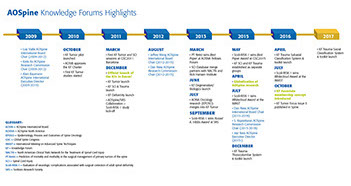
Research that matters –
From creating knowledge to benefiting the patient
The production of research under the KF umbrella started with two studies in 2010, and already at the Global Spine Congress 2011 in Barcelona, the KF Tumor organized its first successful public session.
It took another two years for the first journal article to be published. A strong Research Manager, Peter Langer, and the Research Commission chairperson, Keita Ito, were instrumental in putting things on the right track. Today, the KF managers, Niccole Germscheid and María Alvarez Sánchez, drive more than 30 clinical research projects and dozens of
sub-projects. AOSpine is only starting to harvest the outcomes of these efforts: publication and citations numbers are increasing by the year and results are being transferred into education.
"I knew then, as I know now, that for research to
be effective, you need to run the project over several years, start publishing, and you will still need 5-10 years before you get strong recognition form the community. Despite all efforts of the first five years, we are still in the beginning, this is how research works. We need time to consolidate our position,
to bring knowledge to the practical awareness of doctors around the world. But once we are recognized as a knowledge provider, people will come of their own accord, they want to join, attend our courses; because we are the creators, we are the innovators," Vialle believes.
AOSpine Executive Director Jayr Bass confirms this trend is becoming a reality. Translation into education and determining how to do this best continues to be one of his key priorities: "The ultimate goal of our investment into research is to advance spine care and improve patients' lives."
The initial focus has shifted from bringing the right people in, and from creating the know-how,
to putting the knowledge into practice. Last year, the KF chairpersons were integrated into the International Research Commission, joining the Regional Research officers in the decision-making body. Bass sees this as an important step in taking responsibility for the AOSpine's mission as a whole: "By getting the KF Chairpersons more integrated into AOSpine the vision and the focus of the KFs has broadened beyond research."
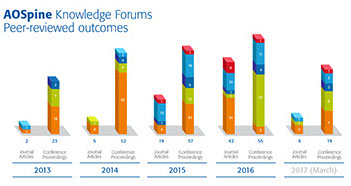
Going global, staying unique
Today, AOSpine is invited to all major orthopedic, spine, and neurosurgical meetings. Vialle is convinced AO is stronger because of the KFs:
"The surgeons of course have their own research, but we take them one level higher by bringing them together. We are uniquely multi-centered, multi-cultural, jumping economical hurdles; bringing regions together and finding international solutions to local problems." The new knowledge has an immediate practical application to patients and perfectly fits with AO's mission to improve patient care.
The International Research Commission chairperson, Dr. Shanmuganathan Rajasekaran,
fully agrees. He, too, was brought into the KF Trauma by Vialle, who presented the idea to him at a spine meeting in Malaysia. Rajasekaran remembers thinking it was a brilliant idea. "We have a huge volume of spinal trauma in India and this could profit the other regions. The power of AO is that it's truly international." The AOSpine Global Research Manager Eberhard Denk is already taking concrete measures to globalize AOSpine research, so that the advantages and successes of each region will benefit of all regions. This has been the leading thought throughout Rajasekaran's chairmanship: "It's about bringing together the capacity of AOSpine members across the world. Regions have their strengths and weaknesses. The best research experience may be in North America. While Asia Pacific or Africa may not be as strong in their experience, they have huge amount of clinical material necessary for clinical research."
The International Research Commission is also introducing associate member structures into the KFs and training surgeons in becoming surgeon-scientists: "All over the world there are young surgeons, who don't have the time, the experience
to do research. By mentoring these bright surgeons, their practice and orientations is transformed and they integrate clinical research into their daily work."
Setting the standard – Back to the roots
In the future, AOSpine is set to provide a high-impact toolset for each of the KF pathologies, consisting of AOSpine classification, staging of
the disease, treatment guidelines, and outcome measures. With this outlook, AOSpine will be the gold standard for whole disease entities and practice in spine care. "We found the right recipe," Gokaslan believes. "We brought in the experts, we provided a platform for generating new knowledge; we created multi-institutional, global data registries, and a universal network of researchers. You could not
be better positioned to be the leader in the field for creating and disseminating new knowledge, for having real impact." Gokaslan sees a day, when somebody anywhere in the world has a spine tumor, the treatment principles will have been established by the AO Foundation. Gokaslan and Bass share the notion of going back to our roots. "If ten years from now you look at the situation, you will see something similar to when the AO was first established in the 1960's. Some decades later, it had become the standard in treating fractures. If we accomplish the same in treating spine diseases and disorders, and we lead the surgical field in this, then I would consider us very successful. I would argue that we are already doing that."
Vialle believes the KFs are the model for the entire AO Foundation. "Education is our key business, but in the future we may not have the industrial partner. Who knows what happens 20 years from now. What are we going to educate people within CMF, VET, and Trauma? With innovation and knowledge produced by us, our core business of education will be fulfilled."
Also Dan Riew believes other clinical divisions may find the KFs an excellent model, given the success
of the venture. He would like to see the KFs expand to cover topics such as infection. "Despite our successes, not everyone in the spine world is aware of the opportunities and benefits KFs provide for the top-notch researcher. It is my hope that in 10 years, we will be widely recognized as the leader in spine research."
These thoughts are widely acknowledged in the KFs. "Looking at the impact in the field, number of publications and presentations, and the new knowledge that is created; the KFs really are the shining star for the AO Foundation," Gokaslan summarizes. But you can always hear a quiet echo in the background: despite their extraordinary success, the KFs still feel uneasy about their future. The need for research is endless, but money is not. Vialle trusts the money invested in research will grow and this will be recognized: "The more money we put in research, the better AO will be recognized as an academic organization. This, I see as the future, this is my vision for 20 years from now."
Read more of the KFs story and their work in the upcoming issues of the AOSpine Newsletter, where we will showcase each KF and their most important study projects.
Enhancing Learning by Taking A Blended Learning Approach
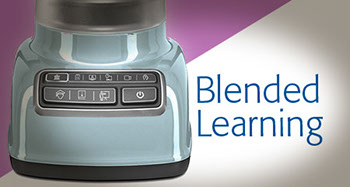
The increase and diversification of digital technology is changing the practice of educating on a global scale. This evolution is changing how students learn, as well as how educators teach, and has enabled the development of new educational models such as blended learning..
With this, AOSpine, as a leader in providing innovative surgeon education, has begun to introduce a blended learning approach to its courses.
What is Blended Learning (or "Flipped Classroom")
Blended learning is an approach to educating that utilizes both online and in-person learning experiences. With blended learning, course participants are often required to complete online pre-course activities, which can include pre-recorded lectures, reading assignments and eLearning activities. This helps to ensure that participants arrive at the face-to-face course with similar levels of knowledge, so that teaching can focus on problem-solving and interactive discussions with faculty members to enhance and deepen the learning experience.
Benefits of Blended Learning
The advantages of a blended learning approach
are centered around the change of time used during face-to-face sessions. Blended learning provides greater interaction between faculty members and course participants. Students also have more flexibility, as they can prepare for a course at a time that suits them best, and review the material as many times as they need. A more engaging learning environment promotes a shift from passive listening to active learning, and also enables students to collaborate more closely with one another.
The key to the success of the blended learning concept is that participants take responsibility for their learning, and come to the course prepared.
Would you like to take part in shaping the future of AOSpine's blended- and online learning activities?
Please take a few minutes to complete this AOSpine Education survey and take the chance to win an AOSpine Masters series book.
https://www.surveymonkey.com/r/NKYCJSL
AOSpine Europe and AOSpine Middle East have successfully collaborated in Istanbul, Turkey



 2 - 4<>
2 - 4<>
After a very successful first collaboration between the AOSpine Europe and Middle East regions in 2014, held in Dubai, the two AOSpine regions went in April 2017 to Istanbul, Turkey. Under the leadership of the Co-Chairpersons Emre Acaroglu (Turkey) and Imad Ahmad (UAE), always supported by Educational Advisor Alpaslan Senkoylu (Turkey), two one-day courses live tissue training courses were running smoothly.
AOSpine's spirit as a global community was mirrored in the people onsite: Faculty from Turkey, the UAE, Pakistan, Iran, and Iraq shared their expertise with participants from eight countries
in total, namely Iraq, Italy, Palestine, Poland, Qatar, Turks, UAE, and the UK in two back to back one-day hands-on courses in a live tissue environment on anesthetized pigs. Participants were trained in different approaches of spine surgery, all in pairs
of two and in a beneficial setting of one faculty and ORP per table. Local experts on general surgery, urology, veterinary, and thoracic surgery were rotating between the tables to share tips and tricks on how to solve complications related to their specialty.
Istanbul proved to be a very well chosen venue
for this event. Not only that the city is easy to reach for both Europeans and Middle Eastern, the CASE Institute under the leadership of Pelin Erkasap,
the institute's Chief Veterinarian, as part of the Acibadem Üniversitesi, freshly renovated three years ago, offers facilities on a very high standard, which are ideal for this kind of educational hands-on events. "To be honest, I did not know what to expect in Istanbul, and I'm positively overwhelmed by the professionality the CASE Institute staff delivers, as well as by their facilities above the state of the art," one European participant mentioned.
Taking into account the good experiences we made, as well as the constructive feedback received, AOSpine Europe and AOSpine Middle East are hoping to continue the successful collaboration with the CASE Institute next year.
AO Interact launches – Achieving more effective patient care worldwide is at the heart of a new video platform
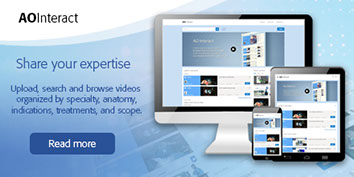
AO Interact, an interactive peer review and discussion video platform for surgeons has launched. AO Interact is a direct, surgeon-driven platform allowing surgeons to upload and manage their own videos supported by additional content, add comments at any point within each other's videos and get an AO community-based peer-review of their uploaded assets.
This new video platform enables surgeons to interact with like-minded people within the AO community, exchange knowledge with subject matter experts in their specialty, enhance resident's education, discuss and perform polls based on their individual topics.
From a blank piece of paper to a meticulously planned, surgeon-tested, interactive video platform: that’s how far the new AO Interact project has come in just three years, with leadership from the AO Education Institute and support from the AO Strategy Fund (AOSF).
AO Interact advances the AO Foundation’s mission to achieve more effective patient care worldwide by providing a valuable, surgeon-driven platform through which surgeons can interact and educate. That interaction and education ranges from sharing and discussing educational videos following AO surgical principles to accessing lectures, webinars and webcasts.
One of the AO Interact project leaders Robin Greene said AOSF support made the project possible.
“We probably would not have been able to take
on this project without the AOSF funding,” he said. “This support gave us the opportunity to do something of great value by creating a platform for the exchange of knowledge throughout the AO’s global network of surgeons and further enhance resident's education.”
Among the biggest milestones in bringing AO Interact to life was perfecting its user experience, after months of intense discussion with the surgeon community and meticulous planning.
“In order to ensure the most intuitive, friendly
and accessible user experience, it was essential to precisely define what the surgeon community wanted that experience to be. So, for every user action—whether it was clicking a button or asking
a surgeon a question about a particular point in a video—we thought-mapped all their critical steps,” Greene explained. “Often, the simplest of websites are the most complex to construct, but it was very important to us to provide a site that delivers the absolute best exchange of knowledge and expertise based on the surgeon's needs.”
Project leader Elmer explained, “AO Interact is unique in its intuitiveness and functionality. One particular function not found on any comparable site allows the user to add a "timeline comment" to
a video. A timeline comment is a comment that is tied to a particular moment in the video, for instance a question about a step in a procedure, which can be added with a simple click of a button. The surgeon who uploaded the video then clicks on the comment and is taken to the related section of that video and discussion thread where they can
add their answer. ”
That feature — and others — underscore the attention the AO Interact team gave the user experience.
“Our senior surgeons are extremely busy, and functions that advance interaction while saving them time are extremely valuable. The AO surgeon community can simply log on to AO Interact with their AO Foundation login."
Support from across the AO community helped make AO Interact a reality, Elmer added.
“The trust the surgeons placed in us is an honor. They have experienced how carefully we use our resources and the attention we brought to AO Interact” he said.
Project manager Michael Henke said, "AO Interact demonstrates the value that AOSF funding delivers to the global AO community in terms of innovation initiatives that advance and achieve more effective patient care."